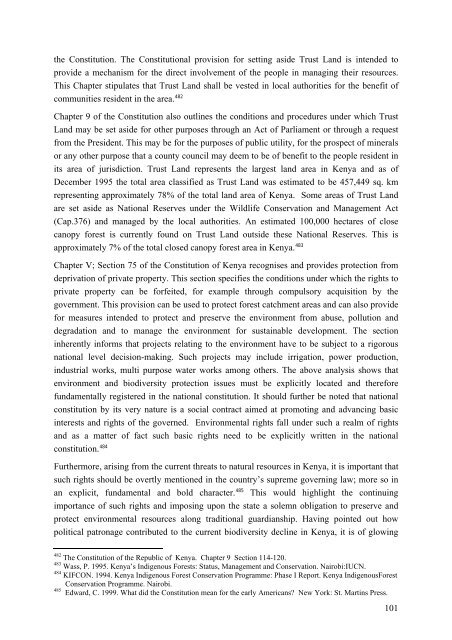THE UNIVERSITY OF LEIPZIG
THE UNIVERSITY OF LEIPZIG
THE UNIVERSITY OF LEIPZIG
Create successful ePaper yourself
Turn your PDF publications into a flip-book with our unique Google optimized e-Paper software.
the Constitution. The Constitutional provision for setting aside Trust Land is intended to<br />
provide a mechanism for the direct involvement of the people in managing their resources.<br />
This Chapter stipulates that Trust Land shall be vested in local authorities for the benefit of<br />
communities resident in the area. 482<br />
Chapter 9 of the Constitution also outlines the conditions and procedures under which Trust<br />
Land may be set aside for other purposes through an Act of Parliament or through a request<br />
from the President. This may be for the purposes of public utility, for the prospect of minerals<br />
or any other purpose that a county council may deem to be of benefit to the people resident in<br />
its area of jurisdiction. Trust Land represents the largest land area in Kenya and as of<br />
December 1995 the total area classified as Trust Land was estimated to be 457,449 sq. km<br />
representing approximately 78% of the total land area of Kenya. Some areas of Trust Land<br />
are set aside as National Reserves under the Wildlife Conservation and Management Act<br />
(Cap.376) and managed by the local authorities. An estimated 100,000 hectares of close<br />
canopy forest is currently found on Trust Land outside these National Reserves. This is<br />
approximately 7% of the total closed canopy forest area in Kenya. 483<br />
Chapter V; Section 75 of the Constitution of Kenya recognises and provides protection from<br />
deprivation of private property. This section specifies the conditions under which the rights to<br />
private property can be forfeited, for example through compulsory acquisition by the<br />
government. This provision can be used to protect forest catchment areas and can also provide<br />
for measures intended to protect and preserve the environment from abuse, pollution and<br />
degradation and to manage the environment for sustainable development. The section<br />
inherently informs that projects relating to the environment have to be subject to a rigorous<br />
national level decision-making. Such projects may include irrigation, power production,<br />
industrial works, multi purpose water works among others. The above analysis shows that<br />
environment and biodiversity protection issues must be explicitly located and therefore<br />
fundamentally registered in the national constitution. It should further be noted that national<br />
constitution by its very nature is a social contract aimed at promoting and advancing basic<br />
interests and rights of the governed. Environmental rights fall under such a realm of rights<br />
and as a matter of fact such basic rights need to be explicitly written in the national<br />
constitution. 484<br />
Furthermore, arising from the current threats to natural resources in Kenya, it is important that<br />
such rights should be overtly mentioned in the country’s supreme governing law; more so in<br />
an explicit, fundamental and bold character. 485 This would highlight the continuing<br />
importance of such rights and imposing upon the state a solemn obligation to preserve and<br />
protect environmental resources along traditional guardianship. Having pointed out how<br />
political patronage contributed to the current biodiversity decline in Kenya, it is of glowing<br />
482<br />
The Constitution of the Republic of Kenya. Chapter 9 Section 114-120.<br />
483<br />
Wass, P. 1995. Kenya’s Indigenous Forests: Status, Management and Conservation. Nairobi:IUCN.<br />
484<br />
KIFCON. 1994. Kenya Indigenous Forest Conservation Programme: Phase I Report. Kenya IndigenousForest<br />
Conservation Programme. Nairobi.<br />
485<br />
Edward, C. 1999. What did the Constitution mean for the early Americans? New York: St. Martins Press.<br />
101






